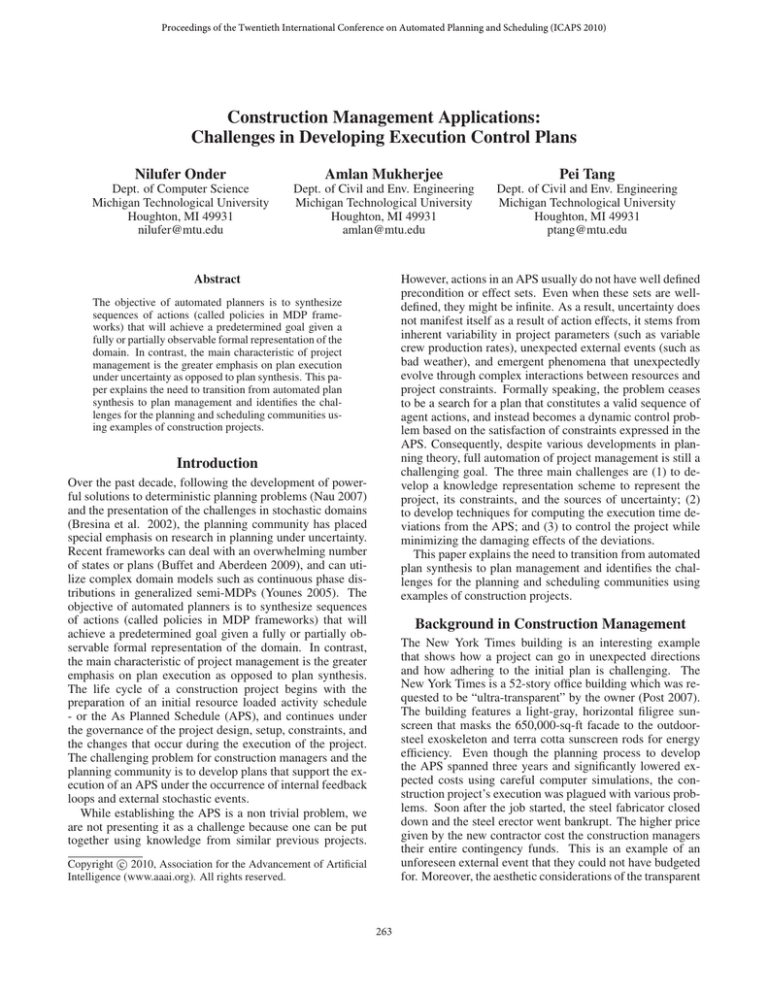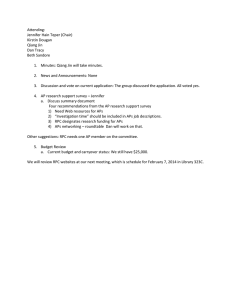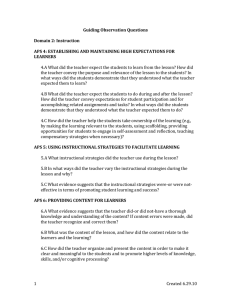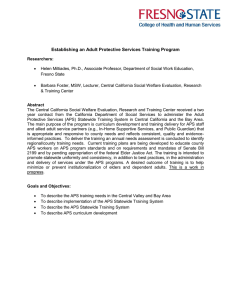
Proceedings of the Twentieth International Conference on Automated Planning and Scheduling (ICAPS 2010)
Construction Management Applications:
Challenges in Developing Execution Control Plans
Nilufer Onder
Amlan Mukherjee
Pei Tang
Dept. of Computer Science
Michigan Technological University
Houghton, MI 49931
nilufer@mtu.edu
Dept. of Civil and Env. Engineering
Michigan Technological University
Houghton, MI 49931
amlan@mtu.edu
Dept. of Civil and Env. Engineering
Michigan Technological University
Houghton, MI 49931
ptang@mtu.edu
However, actions in an APS usually do not have well defined
precondition or effect sets. Even when these sets are welldefined, they might be infinite. As a result, uncertainty does
not manifest itself as a result of action effects, it stems from
inherent variability in project parameters (such as variable
crew production rates), unexpected external events (such as
bad weather), and emergent phenomena that unexpectedly
evolve through complex interactions between resources and
project constraints. Formally speaking, the problem ceases
to be a search for a plan that constitutes a valid sequence of
agent actions, and instead becomes a dynamic control problem based on the satisfaction of constraints expressed in the
APS. Consequently, despite various developments in planning theory, full automation of project management is still a
challenging goal. The three main challenges are (1) to develop a knowledge representation scheme to represent the
project, its constraints, and the sources of uncertainty; (2)
to develop techniques for computing the execution time deviations from the APS; and (3) to control the project while
minimizing the damaging effects of the deviations.
This paper explains the need to transition from automated
plan synthesis to plan management and identifies the challenges for the planning and scheduling communities using
examples of construction projects.
Abstract
The objective of automated planners is to synthesize
sequences of actions (called policies in MDP frameworks) that will achieve a predetermined goal given a
fully or partially observable formal representation of the
domain. In contrast, the main characteristic of project
management is the greater emphasis on plan execution
under uncertainty as opposed to plan synthesis. This paper explains the need to transition from automated plan
synthesis to plan management and identifies the challenges for the planning and scheduling communities using examples of construction projects.
Introduction
Over the past decade, following the development of powerful solutions to deterministic planning problems (Nau 2007)
and the presentation of the challenges in stochastic domains
(Bresina et al. 2002), the planning community has placed
special emphasis on research in planning under uncertainty.
Recent frameworks can deal with an overwhelming number
of states or plans (Buffet and Aberdeen 2009), and can utilize complex domain models such as continuous phase distributions in generalized semi-MDPs (Younes 2005). The
objective of automated planners is to synthesize sequences
of actions (called policies in MDP frameworks) that will
achieve a predetermined goal given a fully or partially observable formal representation of the domain. In contrast,
the main characteristic of project management is the greater
emphasis on plan execution as opposed to plan synthesis.
The life cycle of a construction project begins with the
preparation of an initial resource loaded activity schedule
- or the As Planned Schedule (APS), and continues under
the governance of the project design, setup, constraints, and
the changes that occur during the execution of the project.
The challenging problem for construction managers and the
planning community is to develop plans that support the execution of an APS under the occurrence of internal feedback
loops and external stochastic events.
While establishing the APS is a non trivial problem, we
are not presenting it as a challenge because one can be put
together using knowledge from similar previous projects.
Background in Construction Management
The New York Times building is an interesting example
that shows how a project can go in unexpected directions
and how adhering to the initial plan is challenging. The
New York Times is a 52-story office building which was requested to be “ultra-transparent” by the owner (Post 2007).
The building features a light-gray, horizontal filigree sunscreen that masks the 650,000-sq-ft facade to the outdoorsteel exoskeleton and terra cotta sunscreen rods for energy
efficiency. Even though the planning process to develop
the APS spanned three years and significantly lowered expected costs using careful computer simulations, the construction project’s execution was plagued with various problems. Soon after the job started, the steel fabricator closed
down and the steel erector went bankrupt. The higher price
given by the new contractor cost the construction managers
their entire contingency funds. This is an example of an
unforeseen external event that they could not have budgeted
for. Moreover, the aesthetic considerations of the transparent
c 2010, Association for the Advancement of Artificial
Copyright Intelligence (www.aaai.org). All rights reserved.
263
facade slowed down the welding process. As a result of the
delay, the concrete deck work crew lagged 12 to 14 floors behind the steel hoisting crew. In order to maintain labor flow
and to not slow down the hoisting crew, the hoisted floors
in between had to be inspected frequently for stability. This
was not part of the APS and was introduced to enforce the
safety rules that require stability inspections when too many
floors of hoisting are completed without decking to stabilize
it. This illustrates an example where the domain safety constraints regarding steel construction manifested themselves
unexpectedly given the unique architectural requirements.
In addition, the delays and extra expenses that started from
the unusual welding requirements, and led to costly safety
inspections, propagated through all the project constraints
and caused multiple delays.
From a construction management point of view, advance
development of plans to control crisis scenarios is a difficult
problem, as the contingencies are often difficult to foresee,
and even for foreseeable contingencies, the number of possible responses is immense. In response, several simulationbased frameworks have been developed to help incorporate
uncertainty into the preparation of APSs. In the context
of construction operations, robust discrete event simulation
(DES) platforms have been used based on models that represent relationships between resources on a construction site
and uncertainties in critical parameters (Martinez and Ioannou 1999; Hajjar and AbouRizk 2002). DES models help
project managers understand cost-benefit tradeoffs of the assignment of resources such as equipment and labor. For example, one can determine the optimal number of trucks for
an excavation operation using DES. In the strategic context,
the entire scope of the construction project is modeled. Dynamic Planning Methodology (DPM) is a simulation method
that uses concepts from System Dynamics and allows the
examination of alternative top-down strategies on project
level operational performance metrics (Pena-Mora and Li
2001). For example, it investigates the relationship between
schedule pressure and uncertainty in activity durations during fast-tracking of construction projects. Both of these simulation approaches estimate expected project performance
(operation duration, cost, etc.) under parameter uncertainty
and variations in strategic management approaches (e.g., increasing schedule pressure). They help compare optimal
control measures and examine alternative strategies, given
initial conditions, and the objectives of minimizing idle time
and maximizing productivity. However, they allow limited examination of the project constraints, and the interdependencies between activities. Also, the simulations are
limited to an input-output paradigm that does not allow interactive assessment of alternative execution plans or development of contingency plans. Therefore, they are best used
to support the development of robust APSs for projects. Using this as a point of departure, the investigation of execution
plans is the next logical step.
primary need is to develop and test strategies that optimize
the deviation from the original plan. This need can be further
expressed in terms of the following challenges:
1. How to move from the precondition-action-effect based
representation to an integrated representation of project
specific constraints, resource allocations, and stochastic external events. This frames the problem of execution control as one of checking for constraint satisfaction,
rather than building a sequence of valid actions towards
a goal. The new semantics will support reasoning about
systemic constraint violations and allow inferences about
the impacts of changes. For example, in the New York
Times execution plan, the system should know about the
safety constraints even though they are not relevant to the
initial APS. For novel projects greater parametric uncertainty in activity duration also needs to be represented.
2. How to develop algorithms that can compute deviations
from the APS at the current time point (using metrics of
cost and/or project duration) as well as explore the space
of possible future plan realizations. This is a problem of
computing the significant deviations that pertain to the
current time and to the time points in the remainder of
the project. For example, in the New York Times execution plan the system should infer that the repeated delays
in welding will delay the overall project and, more importantly, stability checks will be required. The timely
discovery of this scenario would allow contingency planning.
3. How to define an execution plan given semantics to represent and reason about the APS, constraints, and uncertainty information; and algorithms to characterize deviations in the APS. Such an execution plan should provide a family of contingencies for a probabilistically characterized space of deviations. In the New York Times
case, consideration of the time-cost trade-off between increasing the number of welding crews while decreasing
the number of hoisting crews, versus introducing aggressive stability checking while keeping the hoisting crew on
schedule, must be part of the solution.
In the next section, we present an implemented project example and point out where each challenge manifests itself.
A Benchmark Problem
Interactive Construction Decision-Making Aid (ICDMA) is
akin to a first person construction manager strategy game
that exposes participants to diverse project management situations that rapidly unfold in time (Watkins, Mukherjee, and
Onder 2008). The participants can react to these scenarios
by making strategic decisions involving resource and activity scheduling, with the goal of completing the project
within schedule and under budget. We use the case of a four
story steel framed office building as an example (Daccarett
and Mrozowski 1999). The construction project is represented by six identical erection sequences each consisting of
the following three activities: Hoisting, Bolting, and Detail
work and Decking. Each activity Ai has a beginning point
Ai,b and an ending point Ai,e . After representing the activities taken from the APS, we put in the constraints that relate
From Plan Synthesis to Plan Management
During the execution of a construction project, at each time
step (this could be a week or a day) the challenge lies in
making decisions with respect to the APS. Therefore, the
264
two time points and associate penalties with various degrees
of delay. For example, for the hoisting activity of sequence
1, the following constraint:
0
k∗
: 1 ≤ H1,e − H1,b ≤ 2
: 2 + k = H1,e − H1,b
says that it will incur a penalty if its duration exceeds 2 days.
For a delay of k days, the activity incurs a penalty which
is computed by a function of k denoted by k ∗ . This delay
represents extra costs due to longer equipment usage or increased labor hours. Examples of constraints considered in
the implementation were:
• Constraint 1: In order to maintain work-flow and efficiently utilize equipment, lag time between hoisting activities for sequence i and (i + 1) should be 0. This is
expressed as: ∞ : Hi+1,b − Hi,e > 0.
• Constraint 2: In order to maintain labor-flow and efficiently manage crew on site, the lag time between bolting
activities for sequence i and (i + 1) should be 0. This is
expressed as: ∞ : Bi+1,b − Bi,e > 0.
Figure 1: ICDMA at t=0
start of the project all constraints are satisfied and the APS
is the state of the system at time t = 0 - represented as S0
(Fig 1). ICDMA uses continuous time advancement, which
is different from the DES frameworks advancing time from
one discrete event to the next. Thus each time point constitutes a control point in the simulation. This is critical because stochastic external events are equally likely to happen
at any point in the project.
Currently TONAE does not represent the adaptive and
emergent uncertainties that arise from spatio-temporal interactions between dynamic relationships among construction
labor crews, decision outcomes, and equipment on site. For
example, inappropriate positioning of a crane can jeopardize
safety and lead to lost productivity from congestion on site.
Project specific causes that set such feedback loops in motion, and balance or reinforce them when control measures
are executed, must also be investigated. Therefore, a representational challenge is to explicitly represent emergent uncertainty and consider the influence of the dynamic evolution of project constraints on the execution control plan.
In order to meet the representational challenges (challenge 1), all the constraints that might be relevant to the
activities in the APS must also be represented. We need
a rich representation including temporal constraints, safety
constraints, and resource constraints such as equipment and
space. The adaptive and emergent behaviors arising from interactions between individual construction components and
site peculiarities also must be modeled explicitly.
The difference between the APS and the as simulated metric at time t is represented as t . ICDMA can compute the
deviations in terms of remaining schedule duration and extra
cost incurred. It can create bins possible futures with respect
to probabilities or costs but does not perform further analysis
(challenge 2).
ICDMA does not have mechanisms to develop responses
to project deviations instead decisions are obtained from the
user. A decision is an assignment or re-assignment of real
numbers to resource and schedule variables (e.g., if 5 more
units of labor is hired then the relevant variable is updated).
• Constraint 3: In order to ensure safety, the hoisting operation for a sequence of a higher storey has to start after a considerable portion of the decking operation for a
sequence of the immediately lower storey had been completed to afford safe fall distances. Appropriate fall distances are maintained by ensuring that the decking operation for operation i starts before the hoisting operation for the sequence (i + 2). This is expressed as:
∞ : Hi+2,b − Di,b > 0.
It is important to note that these constraints are project specific manifestations of construction domain constraints regarding safety and optimal resource utilization.
Disruptions in ICDMA are created when constraints are
violated. These violations can result from external events
or emergent uncertainty inherent to the project. An external
event is a happening that affects the project. An event E is
represented as a triple < Eprec , Ee , Epr >. Eprec is a set
of variable values that enable the occurrence of the event.
Ee is the set of effects the event has on the environment.
It encodes the impacts that the event will have on specific
project parameters, and the variables impacted. The set of
variables affected by an event can be different from the variables included in the preconditions. Epr refers to the probability of event occurrence given that the enabling preconditions are satisfied. For example, a drop in labor productivity
due to adverse weather can be represented as:
Eprec
= { Weather = Snow, Location = outdoor },
Ee
= { Productivity = 50% },
Epr
= { 0.75 }
At each time step in the simulation, ICDMA samples from
the event probability distributions to determine which events
will occur and what the effects will be. It uses a state based
representation using a resource loaded temporal constraint
network, called TONAE ( Temporal Network with Activities
and Events), which represents both temporal and resource
constraints (Anderson, Mukherjee, and Onder 2009). At the
265
The decision set consists of all reassignments and is formulated as Dt when made at the end of time point t.
At the end of each simulation run we generate the following data sets:
• A sequence of system states for each time point during the
length of the simulated project: {St }. The TONAE is the
state of the system at any given time.
• A sequence of decisions taken by the user: {Dt }.
• A sequence of deviations at each time step: {t }.
• A sequence of query distributions recorded at the end of
each time point in the simulation: {Qt }. This is an impact
distribution of a sample of possible future states that St
can transition to.
Hence for each time point for a given run the following situation vector can be recorded as: St = [St , Qt , t , Dt ]. The
decision-making agent arrives at the decision Dt by observing St and Qt , with the objective of minimizing t . The
decision Dt in conjunction with the stochastic occurrence of
an external event is used to update the state of TONAE to
trigger the transition of the system from St to St+1 . The decision Dt made by the agent is driven by high-level philosophies which we refer to as strategies. Examples of such
strategies include a crash strategy where the user increases
resources to decrease project duration, and a reassign strategy where the activities on the critical path are prioritized.
The challenges related to generating contingency responses (challenge 3) are as follows:
• Given a set of k strategies or policies {P0 , P1 , P2 ...Pk },
and N simulation runs with each strategy (total of kN
runs) and the sequences of situation vectors recorded
for each run {St1 , St2 ...Stk }, how do we establish formal
methodologies and approaches to represent and reason
about the efficiency of a strategy?
• The decision-making agent can be a human or an artificial agent. The advantages of using a human agent is
that each decision will take into consideration judgement
and understanding of domain/problem specific knowledge. However, for large values of N it becomes impractical and error prone to have a human agent. Therefore, can
an automated agent be devised that will (i) run the simulation given a particular strategy, (ii) possibly learn from
human agent runs to increase its planning efficiency?
presented in the context of the International Competition
on Knowledge Engineering for Planning and Scheduling
(Barták, Fratini, and McCluskey 2009).
Acknowledgments
This work was supported by the NSF grant SES 0624118
and its REU supplement to Amlan Mukherjee. Any opinions, findings and conclusions or recommendations expressed in this material are those of the authors and do not
necessarily reflect views of the National Science Foundation. We thank anonymous reviewers for their helpful suggestions.
References
Anderson, G. R.; Mukherjee, A.; and Onder, N. 2009.
Traversing and querying constraint driven temporal networks to estimate construction contingencies. Automation
in Construction 18(6):798–813.
Barták, R.; Fratini, S.; and McCluskey, L., eds. 2009. Proceedings of the Third International Competition on Knowledge Engineering for Planning and Scheduling. AAAI
Press.
Bresina, J.; Dearden, R.; Meuleau, N.; Ramakrishnan, S.;
Smith, D.; and Washington, R. 2002. Planning under continuous time and resource uncertainty: A challenge for AI.
In Proceedings of the Eighteenth Conference on Uncertainty
in Artificial Intelligence (UAI-02), 77–84.
Buffet, O., and Aberdeen, D. 2009. The factored policygradient planner. Artificial Intelligence 173:722–747.
Daccarett, V., and Mrozowski, T. 1999. AISC digital library:
Construction management of steel construction. Available via http://www.aisc.org/content.aspx?id=21250 [accessed 10/26/2009].
Hajjar, D., and AbouRizk, S. 2002. Unified modeling
methodology for construction simulation. Journal of Construction Engineering and Management 128(2):174–185.
Martinez, J., and Ioannou, P. 1999. General-purpose system
for effective construction simulation. Journal of Construction Engineering and Management 125(4):265–276.
Nau, D. S. 2007. Current trends in automated planning. AI
Magazine 28(4):43–58.
Pena-Mora, F., and Li, M. 2001. Dynamic planning and
control methodology for design/build fast-track construction
projects. Journal of Construction Engineering and Management 127(1):1–17.
Post, N. M. 2007. High-profile manhattan tower is veteran
builders last hurrah. Engineering News Record.
Watkins, M.; Mukherjee, A.; and Onder, N. 2008. Using
situational simulations to collect and analyze dynamic construction management decision-making data. In Proceedings of the 40th Winter Simulation Conference (WSC-08),
2377–2386.
Younes, H. L. S. 2005. Planning and execution with phase
transitions. In Proceedings of the Twentieth National Conference on Artificial Intelligence (AAAI-05), 1030–1035.
Conclusion
In this paper, we explained the need for knowledge-rich
environments to deal with execution time contingencies
in project management. While the examples and cases
were drawn from construction projects, we believe that the
desiderata are widely applicable to other dynamic project
environments which have soft and hard constraints, variability in activity parameters, and external events affecting the
course of the project.
Good user interfaces are also essential for effective project
management, but are beyond the scope of this paper. One
interesting issue is the development of powerful user interfaces for entering information about stochastic domains. Recently, such interfaces for deterministic domains have been
266






